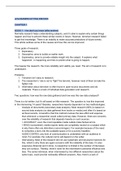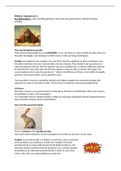unfuniSAMENVATTING EBOOKS
CHAPTER 1
BOOK 1 - the devil you know (silke andrew)
Normally research helps understanding subjects, and it’s able to explain why certain things
happen and how to prevent these similar events in future. However, terrorism research failed
to get this knowledge. There is an inability to make accurate predictions of future events.
This article outlines some of the causes and how this can be improved.
Three goals of research;
1. Exploratory
2. Descriptive; aims to builds on earlier work.
3. Explanatory: aims to provide reliable insight into the subject. It explains what
happened , is happening and tries to predict what is going to happen.
The heavier the research, the more reliability and validity you need. The aim of research is to
understand.
Problems
1. Terrorism isn’t easy to research.
2. The researcher’s ‘role is not to “fight” the terrorist, however most of them do take the
fighter role.
3. Information about terrorism is often found in open-source documents and old
materials. There is a lack of individual data generation and research.
Two questions: how was the raw data gathered and how was this raw data analysed?
There is a lot written, but it’s all based on little research. The question is; has this improved
in the intervening 14 years? Besides, researchers heavily dependent on two methodologies:
- Analysis of documents (secondary data analysis). Most research (80%) is based on
second data analysis (so data gathered from books or media) and often it’s based on
archival records. A benefit is that this method involves the less effort and expense
than whenever a researcher would collect primary data. However, there are concerns
over the reliability of research that depends heavily on such sources:
> ACCURACY; even the most reputable media outlets make factual errors.
> BIAS (vooroordeel); media reports rarely are completely neutral on a subject which
is why there often are distortions (vervormingen). For example because of the need
to compress a story into the available space or for a punchy headline.
AUDIO CONTEX; any form of communication is undertaken with an audience in
mind. For example; the cultural norms will depend on the writer.
- Interviewing. Most of the research did not use systematic and structured manners for
this, which is why there are again concerns with the reliability of the data. It’s also
expensive (financial and in time). A researcher is limited in the number of interviews
they can conduct. Thereby, there’s room for the interviewer’s personal influence and
bias. The same individual, when interviewed by two different researchers about the
same topic, could provide noticeably different answers. Also, there’s a lack of
, anonymity. The presence of the interviewer may make the respondent reluctant to
talk about sensitive issues and may also encourage respondents to give socially
acceptable replies or responses which they think the interviewer wishes to hear.
However, there are also advantages;
> FLEXIBLE METHOD; when anything interesting opens up, the interviewer can add
this.
> GOOD MEASURE OF CONTROL; the interviewer can assure full answers with
specific questions
> GOOD RESPONSE RATES
> EXTRA INFORMATION:
Interviewing / opportunity sampling (???)
little effort is made to sample systematically. This is not entirely unexpected. Opportunity
sampling is a common method when dealing with groups or individuals that are difficult to
access
The sample may be representative, but then again it may not. With opportunity sampling
there is no way to tell. As a result of this uncertainty, opportunity sampling tends to be used
only in exploratory research in the social sciences. The dominance of the method in
terrorism research, though, raises a question mark over the reliability of the information
being generated
Figure 1 (methods in terrorism research)
6% of the published articles in the journals give no indication for the source of their
information: these are written by individuals, probably based on their own personal
experience.
The concerns expressed by Schmid and Jongman in 1988 about the quality of terrorism
research remain. SO IS STILL BAD. Only about 20% of articles provide substantially new
knowledge which was previously unavailable to the field. Moreover; People are extremely
complex, and their behaviour and thoughts are the result of a confusing interaction of
emotions, motivations, learned behaviours and genetically determined traits
Descriptive statistics enable the researcher to summarize and organize data in an effective
and meaningful way. Inferential statistics allow the researcher to make decisions or
inferences by interpreting data patterns. Inferential statistics are regarded as particularly
valuable as they introduce an element of control into research that can help to compensate if
relatively weak data collection methods were used.
Inferential statistics can, however, help to introduce a recognized element of control, so that
there is less doubt and more confidence over the veracity of any findings
Figure 2, however, shows that even though terrorism researchers tend to rely heavily on the
‘weaker’ uncontrolled data-gathering methods, in the past six years very little effort has been
made to balance this by the use of statistical analysis.
,As a result, the subject matter often shares similarities with terrorism in terms of difficult
research populations and real-world relevance, as well as considerable concerns with
human suffering and injustice.
Some 86 per cent of research papers in forensic psychology and 60 per cent of papers in
criminology contain at least some form of statistical analysis. In both cases, inferential
statistics account for the majority of this analysis. In both disciplines, the use of statistics is
seen as an important way to let the claims made by researchers meet recognized quality
controls. In stark contrast, terrorism articles rarely incorporate statistics and when they do
they are nearly five times more likely to be just descriptive statistics.
By forensic psychology & criminology small teams of researchers account a high portion of
the papers. In terrorism only 9.4% of the research is a result of collaborative effort.
Terrorism research – with its very heavy dependence on reviewing published documents
coupled occasionally by opportunistic interviewing – fails to provide the same degree of raw
material to work with.
reden van geen statistics; veel onderzoeken terrorisme zijn door een individueel om
stastieken kosten veel effort.
CONCLUSIONS
Terrorism is a lot of fast-food research: quick, cheap, ready-to-hand and nutritionally
dubious.
How to improve matters? There are too few researchers. Over 90% of research studies are
by just one person working in isolation.
Ultimately, people are more likely to remain active in research – at least to a limited degree –
as long as there are rewarding outlets for their work and interests.
vgm stoppen mensen dus ook vaak met het onderzoek. (?)
one cannot build a structure if the correct raw materials are not available.
If knowledge is deficient, prediction is impossible
we simply should know more about terrorism than we currently do. That we continue to
languish at this level of ignorance on such a serious subject is a cause of grave concern.
, Secondary Data Analysis
Book 2 - what we know and what we do not know (ANJA DALGAARS-NIELSEN)
The aim is to take stock of the current state of research within this field and to answer the
question: From an empirical point of view, what is known and what is not known about
radicalization connected to militant Islamism in Europe?
Why and when do people cross from violent talk to violent action? What prevents others,
exposed to the same political, ideological, and socioeconomic influences, from crossing?
Though the topic has become “hot” in policy circles the empirical knowledge base remains
relatively weak.
This article is based on a review of books, articles, and studies published between 2001 and
2008, including a screening of the journals Terrorism and Political Violence and Studies in
Conflict & Terrorism. It concentrates on studies where interviews were used as primary data.
(kost veel tijd maar is onmisbaar - indespensable when seeking insights into the triggers and
drivers of violent radicalization at group or individual level)
in dit onderzoek: One group of scholars, working within a tradition of French sociology, point
to overall sociological background factors such as globalization and dissolution of traditional
communities and identities. A second group of scholars, working within social movement
theory or network theory, point to group-level variables, such as the dynamics of social
networks and social interaction. A third group, who take an empiricist or case-study-based
approach, points to individual level factors such as specific individual needs or inclinations.
Definitions and delimitation
The terms “radical” and “radicalization” mean different things to different people. Here, a
radical is understood as a person harboring a deep-felt desire for fundamental sociopolitical
changes and radicalization is understood as a growing readiness (gereedheid) to pursue and
support farreaching (ingrijpende) changes in society that conflict with, or pose a direct threat
to, the existing order.
Violent radicalization; a process in which radical ideas are accompanied by the development
of a willingness to directly support or engage in violent acts
Militant Islamism is newer to Europe than other radicalizing ideologies and thus still less well
researched and, arguably, less well understood. groups inspired by militant Islamism
currently pose the most severe (ernstig) terrorist threat to Europe
Militant Islamism claims that in order to return to a society of peace, harmony, and social
justice, Muslims need to unite and stand up for their faith. They need to fight the West and
other corrupting influences. Violence, including violence against civilians, is a necessary and
legitimate means given the superior military power of the West. The fight, which militant
Islamism claims is a religiously sanctioned fight, is an individual duty and an emancipatory
journey, which brings the fighter closer to God
In USA en Canada; also experienced ‘homegrown’ plots, but the cases remain fewer than in
Europe.






